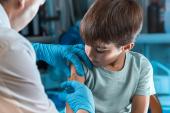Knowns, Unknowns of Vaccine Myocarditis Risks Summarized in ‘Living’ Review
A large, rigorous evidence review confirms the emerging picture of a very rare side effect and highlights the need for follow-up.

The largest evidence review to date addressing the risk of myocarditis following COVID-19 vaccination confirms many of the same findings that have accumulated over the last 16 months: male adolescents and young adults are at the highest risk after an mRNA vaccine, the Moderna vaccine carries more risk than Pfizer’s, and delaying the second dose appears to provide some protection.
Also, in the vast majority of cases, myocarditis symptoms were “mild and self-limiting,” the caveat being that longer-term data are still needed.
“The early research was case reports and case series, which are really important to flag that a problem exists. However, we weren't able to fully understand the extent of the problem until we had those larger studies and population-based studies to calculate true incidence rates and really identify if this was a concern beyond the baseline incidents of myocarditis that we would typically see,” senior author on the paper, Lisa Hartling, PhD (Alberta Research Centre for Health Evidence, Edmonton, Canada), told TCTMD.
“These larger studies are always important to see patterns, and we've started to see more patterns around, for example, second dose, the interval between dosing, comparing the different vaccines. Some of these details and nuances weren't apparent in the earlier studies or when you're just looking at individual studies,” she said. “As we see more studies emerge, they're becoming more refined.”
This “living evidence syntheses and review,” published last week in the BMJ, considered nearly 6,500 citations from 2021 and 2022, submitting the research to a series of qualifying questions and excluding publications according to a rigorous set of standards before including a total of 46 studies of adequate size and quality. Indeed, the explosion of research in this area is one of the reasons why this review was necessary, said Hartling.
“I think it's precisely because of the enormous amount of studies and research that this review is critically important. To put that in context, when we did our first literature search back in November [2021], we identified close to 3,500 studies to screen. Just 2 months later, we identified another 2,000,” she explained. “So, certainly, the literature around this topic is growing very quickly.”
I think it's precisely because of the enormous amount of studies and research that this review is critically important. Lisa Hartling
In addition to the findings refining the understanding of who and when people might be at risk for myocarditis following vaccination—and the size of that risk—the analysis also offered reassurances for those worried or affected, noted cardiologist and co-author Ian Paterson, MD (University of Alberta, Edmonton, Canada).
“Myocarditis is certainly one of the potential side effects that we need to discuss with patients who have questions about the vaccine, and in my case, when I'm talking to cardiac patients who have preexisting cardiac disease, this is something that comes up,” Paterson said. “As a cardiologist who's seeing these patients, I think the key messages, which our work helps to confirm, is that myocarditis related to mRNA vaccine is actually a very rare side effect. . . . In most cases, this looks like a risk that's less than 20 per million doses.”
The second take-home message, he said, “is that the group of patients that seems to be at the highest risk seem to be young males and adolescent males. And there we're talking about a risk up to about 145 to 150 cases per million doses.”
The third takeaway relates to severity, Paterson continued. “The myocarditis related to the vaccine is self-limiting so patients, at least on the short term, tend to do very well. In the review that we conducted, many patients were observed in-hospital for a very short period of time, and they were discharged without any apparent sequalae—it tends to be what we would call [a] self-limiting problem.” The caveat, he added, is that long-term data are still lacking, and this is a key focus of the ongoing review to be included in the future.
Jennifer Pillay, MSc (Alberta Research Centre for Health Evidence), lead author on the analysis, noted that their ongoing surveillance of the data includes patients with at least 3 months follow-up and said that, from what they’ve seen so far, longer-term outcomes are consistent with the view that the myocardial inflammation resolves. Still, their intention is to continue to follow patients and keep their “living” document updated. “Typically we need to wait a year or even a few years to potentially find out longer-term, more serious consequences,” Pillay said. “So it will take a while.”
Future updates, she noted, will be posted to the COVID-END website hosted by the McMaster Health Forum, Hamilton, Canada.
Key Results
The findings reported in the review are largely in line with others from smaller case series and population reports, previously reported by TCTMD.
- Myocarditis rates were highest in adolescent and young adult males, ranging from 50-139 cases per million in those aged 12-17 years and 28-147 per million in males aged 18-29
- Rates fell to fewer than 20 cases per million for girls and boys aged 5-11 and women aged 18-29 years
- Myocarditis risk is “probably higher” after vaccination with the Moderna as compared with the Pfizer vaccine, most notably in males aged 18-29
- Based on observations in the male/18-29 age group, a dosing interval of 56 days or more may reduce myocarditis risks, as compared with an interval of 30 days or less
To TCTMD, Hartling acknowledged that the myocarditis story has been scary for many patients and parents, complicating the decision to get vaccinated. To that end, the current project included patient partners with “lived experience”—people who had relatives with myocarditis or those considered higher risk—who reviewed the evidence, developed interpretations from the patient perspective, and weighed in on what they believed key messages should be from the paper. COVID-END also includes plain-language summaries of the reviews and their findings.
“There's a lot of concern regarding misinformation in the context of the pandemic and in the context of the vaccine, so I would hope that people see this as a comprehensive and rigorous assessment of what's out there,” Hartling said.
It tends to be what we would call self-limiting problem. Ian Paterson
Further follow-up is needed on existing patient cohorts, as well as new data confronting even very rare vaccine risks alongside those posed by newer strains of COVID-19, but according to Paterson, “there's still reason to believe that the vaccine would benefit individuals far more than any risk [posed by] the vaccine” itself.
That’s echoed in an accompanying editorial which takes a tough stance on the evidence base to date, calling the lack of certitude around long-term outcomes “disappointing.”
“Key uncertainties remain,” write Jing Luo MD, MPH (University of Pittsburgh School of Medicine, PA), and Walid F. Gellad, MD, MPH (VA Pittsburgh Healthcare System, PA), “including risks associated with boosters, risks associated with primary vaccination of young children, and the long-term outcomes of those who experience myocarditis.”
Still, say Luo and Gellad, “these uncertainties must be placed in the context of the substantial and widely accepted benefits of vaccination.”
For TCTMD’s full conversation with Pillay, Paterson, and Hartling, tune in to the July 2022 edition of Heart Sounds.
Shelley Wood was the Editor-in-Chief of TCTMD and the Editorial Director at the Cardiovascular Research Foundation (CRF) from October 2015…
Read Full BioSources
Pillay J, Gaudet L, Wingert A, et al. Incidence, risk factors, natural history, and hypothesized mechanisms of myocarditis and pericarditis following COVID-19 vaccination: living evidence syntheses and review. BMJ. 2022;378:e069445.
Luo J, Gellad WF. Myocarditis and pericarditis risk after COVID-19 vaccination. BMJ. 2022;378:o1554.
Disclosures
- Pillay, Paterson, and Hartling report having no relevant conflicts of interest.
- Luo reports serving as an uncompensated physician advisor to the VA Center For Medication Safety





Comments